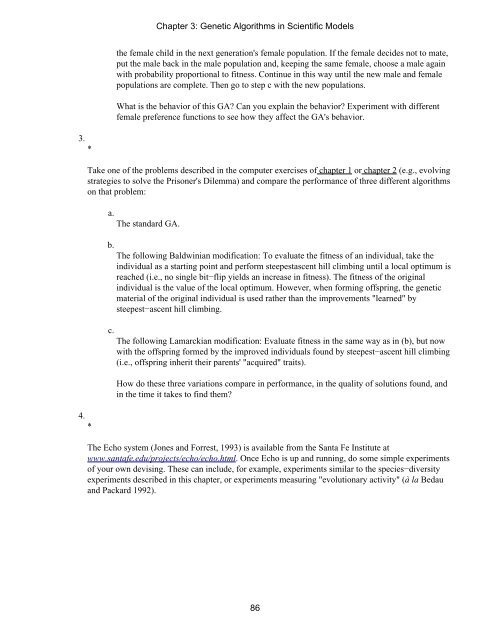An Introduction to Genetic Algorithms - Boente
An Introduction to Genetic Algorithms - Boente
An Introduction to Genetic Algorithms - Boente
Create successful ePaper yourself
Turn your PDF publications into a flip-book with our unique Google optimized e-Paper software.
3.<br />
*<br />
4.<br />
*<br />
the female child in the next generation's female population. If the female decides not <strong>to</strong> mate,<br />
put the male back in the male population and, keeping the same female, choose a male again<br />
with probability proportional <strong>to</strong> fitness. Continue in this way until the new male and female<br />
populations are complete. Then go <strong>to</strong> step c with the new populations.<br />
What is the behavior of this GA? Can you explain the behavior? Experiment with different<br />
female preference functions <strong>to</strong> see how they affect the GA's behavior.<br />
Take one of the problems described in the computer exercises of chapter 1 or chapter 2 (e.g., evolving<br />
strategies <strong>to</strong> solve the Prisoner's Dilemma) and compare the performance of three different algorithms<br />
on that problem:<br />
a.<br />
The standard GA.<br />
b.<br />
c.<br />
Chapter 3: <strong>Genetic</strong> <strong>Algorithms</strong> in Scientific Models<br />
The following Baldwinian modification: To evaluate the fitness of an individual, take the<br />
individual as a starting point and perform steepestascent hill climbing until a local optimum is<br />
reached (i.e., no single bit−flip yields an increase in fitness). The fitness of the original<br />
individual is the value of the local optimum. However, when forming offspring, the genetic<br />
material of the original individual is used rather than the improvements "learned" by<br />
steepest−ascent hill climbing.<br />
The following Lamarckian modification: Evaluate fitness in the same way as in (b), but now<br />
with the offspring formed by the improved individuals found by steepest−ascent hill climbing<br />
(i.e., offspring inherit their parents' "acquired" traits).<br />
How do these three variations compare in performance, in the quality of solutions found, and<br />
in the time it takes <strong>to</strong> find them?<br />
The Echo system (Jones and Forrest, 1993) is available from the Santa Fe Institute at<br />
www.santafe.edu/projects/echo/echo.html. Once Echo is up and running, do some simple experiments<br />
of your own devising. These can include, for example, experiments similar <strong>to</strong> the species−diversity<br />
experiments described in this chapter, or experiments measuring "evolutionary activity" (à la Bedau<br />
and Packard 1992).<br />
86






